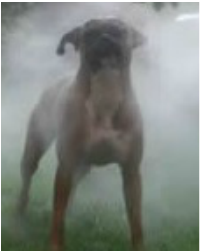 Arthur's dog Cavall, lost in the mist of time
Arthur's dog Cavall, lost in the mist of time The early Welsh legends of King Arthur mention that he had a favorite dog, a magical boar hunting hound by the name of Cavall. So magical was Cavall that the footprint he made in a rock was listed by Ninnius the 9th century historian as one of the Wonders of Britain. His killing of a wild boar is marked by a statue in Ammanford, Wales. What kind of dog was Cavall? Is he represented today among our multitude of well-bred house dogs, lap dogs and show dogs, or have dogs like Cavall been lost in the mists of time, just as Arthur has been lost?
 Roman soldier with a Mollosus War Dog
Roman soldier with a Mollosus War Dog It is possible that Cavall was a Mollosus, a war dog from Southern Europe who traveled with the Roman legions. If Arthur was part of the Roman army invading Britain, or a descendant of the legions who joined in the war against the invading Saxons, his dog may have been a Mollosus. The descendants of the Molossus are still with us in the massive breeds such as the Great Dane, the Rottweiler and the Newfoundland.
 Roman mosaic of British Agassian dog
Roman mosaic of British Agassian dog Wherever the Romans went, the Molossus was greatly feared, but the British had their own dogs. Not only were the British dogs aggressive, they were apparently incredibly ugly, and yet they were considered one of Britain's most valuable exports as hunting dogs. Oppian, the 3rd Century Greco-Roman poet described these dogs in admiring but unflattering terms, and they are believed to be the ancestors of the Welsh Springer Spaniel.
"There is a strong breed of hunting dog, small in size but no less worthy of great praise. These the wild tribes of Britons with their tattooed backs rear and call by the name of Agassian. Their size is like that of worthless and greedy domestic table dogs; squat, emaciated, shaggy, dull of eye, but endowed with feet armed with powerful claws and a mouth sharp with close-set venomous tearing teeth. It is by virtue of its nose, however, that the Agassian is most exalted, and for tracking it is the best there is; for it is very adept at discovering the tracks of things that walk upon the ground, and skilled too at marking the airborne scent."
 The lovable Welsh Springer Spaniel
The lovable Welsh Springer Spaniel Spaniel owners might not agree that their pooch has close-set venomous tearing teeth, or that he is squat and emaciated, but we all know their ability to track and find scents. The Welsh Springer today is a thing of beauty, but he still has that "nose".
Are there any other contenders for the title of King Arthur's dog? Undoubtedly Arthur and his court had a stable of Gaze Hounds, dogs who hunted by sight. When the medieval knight was not engaged in warfare, jousting, or courtly love, he was out hunting and the Gaze Hound, ancestor of the Greyhound, the Whippet and the Saluki was the hound of choice.
 The turnspit all purpose dog for castle and cottage
The turnspit all purpose dog for castle and cottage There were other dogs around the castle, lowly mongrels who served as rat catchers, kitchen workers and even foot warmers. The turnspit dog was perhaps the most overlooked and yet the most useful as it was his job to run in the wheel that turned the roast over the fire. Even the lowliest cottage would have at least two turnspit dogs, one to run in the wheel and one as a relief. We might think that they were poorly treated but because of their dual role as spit turners and foot warmers, they often slept in the bed, sat at the master's feet, or even went to church. Turnspit dogs were low to the ground, long bodied and strong in the chest, The breed is now considered extinct but the Welsh Corgi is thought to be their descendant.
 Queen Elizabeth II with her corgis.
Queen Elizabeth II with her corgis. Arthur's dog is long gone, the Molossus no longer exists, the Agassian has become a spaniel, the Gaze Hound has morphed into a racing dog, but the humble turnspit dog has become royalty as the chosen favorite of Queen Elizabeth II. So who is top dog now?
I am pleased to have included a couple of canine companions for the adventurers in Excalibur Rising. Amigo is a Welsh Shepherd dog, a very rare breed. You can meet him in Book One, and get to know him better in Book Two, and there will be more four footed friends to come in Books Three and Four.
I am pleased to have included a couple of canine companions for the adventurers in Excalibur Rising. Amigo is a Welsh Shepherd dog, a very rare breed. You can meet him in Book One, and get to know him better in Book Two, and there will be more four footed friends to come in Books Three and Four.
For more information on the mythology of Cavall see the entries in Bullfinches Mythology

 RSS Feed
RSS Feed